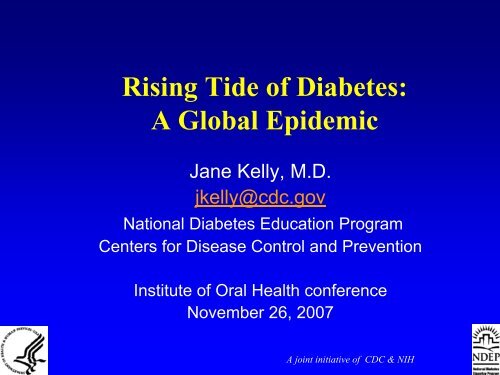PPT (5 MB) - Institute for Oral Health
PPT (5 MB) - Institute for Oral Health
PPT (5 MB) - Institute for Oral Health
Create successful ePaper yourself
Turn your PDF publications into a flip-book with our unique Google optimized e-Paper software.
Rising Tide of Diabetes:<br />
A Global Epidemic<br />
Jane Kelly, M.D.<br />
jkelly@cdc.gov<br />
National Diabetes Education Program<br />
Centers <strong>for</strong> Disease Control and Prevention<br />
<strong>Institute</strong> of <strong>Oral</strong> <strong>Health</strong> conference<br />
November 26, 2007<br />
A joint initiative of CDC & NIH
Objectives<br />
• Describe the rising global burden of<br />
diabetes<br />
• Describe key findings of landmark<br />
studies in diabetes care and prevention<br />
• Identify the National Diabetes<br />
Education Program (NDEP) as a<br />
resource <strong>for</strong> free evidence-based,<br />
culturally-appropriate educational<br />
materials<br />
A joint initiative of CDC & NIH
What is Diabetes?<br />
• Diabetes is a group of diseases<br />
characterized by high levels of blood glucose<br />
(blood sugar)<br />
Fasting glucose > 126<br />
75 gram OGTT 2 hour value > 200<br />
Or<br />
Random glucose > 200 with symptoms<br />
(excessive thirst/urination, dizziness,<br />
blurred vision, weight loss, fatigue)<br />
Diabetes can lead to serious health problems<br />
and premature death<br />
NIDDK, National Diabetes Statistics fact sheet. HHS, NIH, 2005.<br />
A joint initiative of CDC & NIH
Why Does Diabetes Continue to<br />
Command Our Attention?<br />
Because EVERY 24 HOURS there are:<br />
• 4,100 new cases of diabetes,<br />
• 810 deaths due to diabetes,<br />
• 230 amputations,<br />
• 120 kidney failures, and<br />
• 55 new cases of blindness<br />
Source: NIDDK, National Diabetes Statistics fact sheet. HHS, NIH, 2005.<br />
A joint initiative of CDC & NIH
Estimated Cost of Diabetes<br />
in the United States<br />
• Direct Medical<br />
Cost: $92 billion<br />
• Indirect Cost:<br />
$40 billion<br />
• Total Cost:<br />
$132 billion<br />
Source: Lewin Group, Inc., <strong>for</strong> the American Diabetes Association, 2002.<br />
A joint initiative of CDC & NIH
Common Types of Diabetes<br />
Type 1 diabetes<br />
• 5% to 10% of diagnosed cases of<br />
diabetes<br />
Type 2 diabetes<br />
• 90% to 95% diagnosed cases of<br />
diabetes<br />
NIDDK, National Diabetes Statistics fact sheet. HHS, NIH, 2005.<br />
A joint initiative of CDC & NIH
Common Types of Diabetes<br />
Gestational diabetes mellitus<br />
• 7% of all U.S. pregnancies, or about<br />
200,000 cases annually<br />
• Increased lifelong risk <strong>for</strong> mother and<br />
child <strong>for</strong> developing type 2 diabetes<br />
NIDDK, National Diabetes Statistics fact sheet. HHS, NIH, 2005.<br />
A joint initiative of CDC & NIH
A joint initiative of CDC & NIH
A joint initiative of CDC & NIH
Type 2 Diabetes<br />
Prediabetes<br />
Obesity<br />
Sedentary<br />
Lifestyle<br />
Beta Cell Defect<br />
Insulin<br />
Resistance<br />
Gender<br />
A joint initiative of CDC & NIH<br />
Age<br />
Puberty<br />
Genetics<br />
Ethnicity
Risk Factors <strong>for</strong> Diabetes<br />
Older age<br />
Overweight (BMI ≥ 25)*<br />
Hypertension*<br />
Abnormal lipid levels*<br />
Family history of diabetes<br />
Race/ethnicity<br />
History of gestational<br />
diabetes<br />
History of vascular<br />
disease<br />
Signs of insulin<br />
resistance<br />
PCOS<br />
Inactive lifestyle*<br />
Previous IGT or IFG*<br />
*Modifiable risk factors<br />
American Diabetes Association. Diabetes Care 2007; 30;(Suppl.1):S4-41.<br />
A joint initiative of CDC & NIH
Does obesity really matter?<br />
Let’s look at some maps<br />
A joint initiative of CDC & NIH
Obesity Trends* Among U.S. Adults<br />
BRFSS, 1991, 1996, 2003<br />
(*BMI ≥30, or about 30 lbs overweight <strong>for</strong> 5’4” person)<br />
1991<br />
1996<br />
2003<br />
No Data
A joint initiative of CDC & NIH
Diabetes and Obesity:<br />
Prevalence (%)<br />
7.5<br />
7.0<br />
6.5<br />
6.0<br />
5.5<br />
5.0<br />
4.5<br />
4.0<br />
The Continuing Epidemic<br />
Diabetes<br />
Mean body weight<br />
1990 1992 1994 1996 1998 2000<br />
Year<br />
Mokdad et al. Diabetes Care. 2000;23:1278.<br />
Mokdad et al. JAMA. 1999;282:1519.<br />
Mokdad et al. JAMA. 2001;286:1195.<br />
kg<br />
78<br />
77<br />
76<br />
75<br />
74<br />
73<br />
72<br />
• Prevalence of obesity,<br />
increased by 61% since<br />
1991<br />
• More than 60% of US<br />
adults are overweight<br />
• BMI and weight gain<br />
major risk factors <strong>for</strong><br />
diabetes<br />
A joint initiative of CDC & NIH
Worldwide Diabetes Prevalence<br />
Estimated Prevalence (millions)<br />
80<br />
70<br />
60<br />
50<br />
40<br />
30<br />
20<br />
10<br />
1995<br />
2000<br />
2025 (projected)<br />
0<br />
Africa Americas Eastern<br />
Mediterranean<br />
Europe<br />
Southeast<br />
Asia<br />
A joint initiative of CDC & NIH<br />
Western<br />
Pacific
Causes<br />
• Population aging and growth<br />
• Urbanization and industrialization<br />
• Increasing obesity<br />
• Unhealthy diets and sedentary<br />
lifestyle<br />
• Genetic component likely<br />
A joint initiative of CDC & NIH
Burden of Diabetes<br />
• Dietary changes world wide:<br />
– Lose of interest in culturally<br />
distinct foods
Fast food restaurants target food<br />
trends within a country<br />
Red Bean Sunday
Lining up to eat at McDonalds in Moscow<br />
A joint initiative of CDC & NIH
1990: Another rush to eat at McDonalds in Russia<br />
A joint initiative of CDC & NIH
Countries With Largest<br />
Number of People With<br />
Diabetes<br />
• India 19 million 57<br />
million<br />
• China 16 million 38<br />
million<br />
• USA 14 million 22<br />
million<br />
• Pakistan<br />
15 million<br />
1995 2025<br />
4 million<br />
A joint initiative of CDC & NIH
Diabetes Stats in the US<br />
• #1 cause of blindness<br />
• #1 cause of kidney failure<br />
• #1 cause of non-traumatic amputation<br />
• Major contributor to the #1 cause of death<br />
in the United States: heart disease and<br />
stroke<br />
A joint initiative of CDC & NIH
Mortality in Patients With Diabetes<br />
Causes of Death<br />
50<br />
40<br />
Deaths (%)<br />
30<br />
20<br />
10<br />
0<br />
CHF/CAD<br />
Diabetes Cancer Stroke Infection Other<br />
Geiss LS et al. In: Diabetes in America. 2nd ed. 1995; ch 11.<br />
A joint initiative of CDC & NIH
Diabetes<br />
touches<br />
everything<br />
A joint initiative of CDC & NIH
This is what a person with normal<br />
vision sees<br />
A joint initiative of CDC & NIH
This is what a person with<br />
diabetic retinopathy sees<br />
A joint initiative of CDC & NIH
A joint initiative of CDC & NIH
People with diabetes and<br />
severe periodontitis have:<br />
• 6x increased risk of poor glycemic control<br />
• 82% of had 1 or more macrovascular<br />
complication (CVD, CVA) (vs 21% w/o)<br />
• Death rate due to CVD= 2.3x higher<br />
• Death rate from nephropathy= 8.5x<br />
A joint initiative of CDC & NIH
Diabetes is serious, common, costly<br />
yet controllable<br />
• Affects over 21 million people in the<br />
United States<br />
• Over 6 million have DM and do not<br />
know it.<br />
• Costs over $132 billion/year in health<br />
care expenditures<br />
• One of the six leading causes of death<br />
• Effective interventions promote multiple<br />
good outcomes<br />
A joint initiative of CDC & NIH
Diabetes Control and Complications<br />
Trial (DCCT)<br />
Compared effects of two diabetes<br />
treatment regimens – standard therapy<br />
and intensive control – on the<br />
complications of diabetes<br />
DCCT. New England Journal of Medicine, 329(14), September 30, 1993.<br />
A joint initiative of CDC & NIH
DCCT Findings<br />
Lowering blood glucose from average A1C<br />
of 7.9 to 7.0 reduced risk of:<br />
• Eye disease by 76%<br />
• Kidney disease by 50%<br />
• Nerve disease by 60%<br />
That’s the difference between an average<br />
blood glucose of 150 and 180<br />
DCCT. New England Journal of Medicine, 329(14), September 30, 1993.<br />
A joint initiative of CDC & NIH
DCCT Findings<br />
Glucose control is key to preventing<br />
or delaying complications of diabetes<br />
Any sustained lowering of blood<br />
glucose helps, even if the person has<br />
a history of poor control<br />
DCCT. New England Journal of Medicine, 329(14), September 30, 1993.<br />
A joint initiative of CDC & NIH
Epidemiology of Diabetes<br />
Interventions and Complications<br />
Study (EDIC)<br />
Observational study<br />
DCCT participants<br />
Looked at risk factors <strong>for</strong> long-term complications<br />
DCCT/EDIC N Engl J Med 2005: 353:2643-2653.<br />
A joint initiative of CDC & NIH
EDIC Findings: Intensive Therapy<br />
and Diabetes Complications<br />
Participants continue to benefit from<br />
metabolic memory of intense glucose control<br />
Intensive therapy aimed at achieving<br />
near normoglycemia:<br />
•Reduces CVD events by more than half<br />
•Should be implemented as early as<br />
possible<br />
DCCT/EDIC N Engl J Med 2005: 353:2643-2653.<br />
A joint initiative of CDC & NIH
EDIC Findings: Cardiovascular Events<br />
0.12<br />
Cumulative Incidence of First of Any Event<br />
Cumulative Incidence<br />
0.10<br />
0.08<br />
0.06<br />
0.04<br />
0.02<br />
Risk reduction 42%<br />
95% CI: 9% to 63%<br />
P = 0.02<br />
Conventional<br />
Intensive<br />
0.00<br />
0 1 2 3 4 5 6 7 8 9 10 11 12 13 14 15 16 17 18 19 20 21<br />
DCCT/EDIC N Engl J Med 2005: 353:2643-2653.<br />
Years from Study Entry<br />
A joint initiative of CDC & NIH
EDIC Findings: Cardiovascular Events<br />
0.12<br />
Non-Fatal MI, Stroke, or CVD Death<br />
Cumulative Incidence<br />
0.10<br />
0.08<br />
0.06<br />
0.04<br />
0.02<br />
Risk reduction 57%<br />
95% CI: 12% to 79%<br />
P = 0.02<br />
Conventional<br />
Intensive<br />
0.00<br />
0 1 2 3 4 5 6 7 8 9 10 11 12 13 14 15 161<br />
6 17 18 19 20 21<br />
DCCT/EDIC N Engl J Med 2005: 353:2643-2653.<br />
Years from Study Entry<br />
A joint initiative of CDC & NIH
United Kingdom Prospective<br />
Diabetes Study (UKPDS)<br />
Clinical Trial<br />
Looked at intensive management of blood<br />
glucose levels and long term risk-factors <strong>for</strong><br />
diabetes complications<br />
UKPDS. BMJ. 2000; 321:405-412.<br />
A joint initiative of CDC & NIH
UKPDS<br />
Improved blood pressure<br />
control reduces risk of:<br />
• Retinopathy progression (34%)<br />
• Vision loss (47%)<br />
• Diabetes-related deaths (32%)<br />
• Microvascular disease (37%)<br />
• Heart failure (56%)<br />
• Stroke (44%)<br />
United Kingdom Prospective Diabetes Study<br />
A joint initiative of CDC & NIH
ABCD<br />
&<br />
ACE inhibitor reduces<br />
risk of:<br />
HOPE<br />
• Heart attack<br />
• Stroke<br />
• CV death<br />
And slows kidney disease.<br />
A joint initiative of CDC & NIH
CARE<br />
&<br />
4S<br />
Lipid therapy reduces<br />
risk of coronary events<br />
• Cholesterol and Recurrent<br />
Events Trial (CARE)<br />
Reduced risk by 24 %<br />
• Scandinavian Simvastatin<br />
Survival Study (4S)<br />
Reduced risk by 42 to 55%<br />
A joint initiative of CDC & NIH
SEARCH<br />
For Diabetes in Youth Study<br />
• Observational study<br />
• Physician-diagnosed diabetes in youth<br />
ages 0-19<br />
• Data will help researchers better<br />
understand and treat diabetes in young<br />
people<br />
(SEARCH). Diabetes Care 2006 29(8): 1891-6.<br />
A joint initiative of CDC & NIH
SEARCH Findings<br />
Determine prevalence and correlates of<br />
selected CVD risk factors among youth with<br />
diabetes<br />
21% of young people with diabetes had at least<br />
two CVD risk factors<br />
Prevalence of CVD risk factors was higher<br />
among youth aged 10-19 years and among<br />
young girls<br />
(SEARCH). Diabetes Care 2006 29(8): 1891-6.<br />
A joint initiative of CDC & NIH
SEARCH Findings<br />
In young people with type 2 diabetes<br />
• 92% had at least two CVD risk factors<br />
In young people with type 1 diabetes<br />
• 14% had at least two CVD risk factors<br />
(SEARCH). Diabetes Care 2006 29(8): 1891-6.<br />
A joint initiative of CDC & NIH
The Face of Diabetes is Getting<br />
Younger<br />
A joint initiative of CDC & NIH
Stages in the natural history<br />
of Type 2 diabetes<br />
Normal<br />
IGT<br />
Type 2 DM<br />
Complications<br />
Disability<br />
Death<br />
Genetic<br />
predisposition<br />
Preclinical<br />
state<br />
Clinical<br />
disease<br />
Complications<br />
Disability<br />
Death<br />
Primary Secondary Tertiary<br />
prevention prevention prevention<br />
A joint initiative of CDC & NIH
Estimated 54 million Americans<br />
ages 40-74 have pre-diabetes<br />
• Pre-diabetes is a condition where blood<br />
sugar levels are higher than normal, but<br />
not high enough <strong>for</strong> diabetes.<br />
• Impaired fasting glucose FBS of 100-125<br />
Or<br />
• Impaired glucose tolerance<br />
– 2 hour OGTT value of 140-199<br />
• People with pre-diabetes are at an<br />
increased risk <strong>for</strong> developing diabetes.<br />
A joint initiative of CDC & NIH
Diabetes Prevention Program (DPP)<br />
Lifestyle Intervention<br />
Intensive Lifestyle Modification<br />
A comprehensive program with the<br />
following specific aims:<br />
• Reduction of fat and calorie intake<br />
• Physical activity at least 150 minutes / wk<br />
• > 7% loss of body weight<br />
• Reduced risk of diabetes 58%<br />
Worked in all ethnicities, all ages<br />
A joint initiative of CDC & NIH
Diabetes Prevention Program<br />
Among people 60 and<br />
older, lifestyle changes<br />
reduced the development<br />
of diabetes by 71 percent.<br />
A joint initiative of CDC & NIH
What’s all this got to<br />
do with me?<br />
A joint initiative of CDC & NIH
What’s all this to do with me?<br />
• Number of people in your practice with diabetes<br />
has dramatically increased<br />
• Diabetes will continue to rise<br />
• Diabetes onset and complications at earlier age<br />
• Metabolic control of diabetes influences oral<br />
health outcomes<br />
• <strong>Oral</strong> health providers may be front line position<br />
<strong>for</strong> influencing patient behavior – diabetes<br />
management and primary prevention<br />
A joint initiative of CDC & NIH
National Diabetes Education Program<br />
Changing the Way Diabetes Is Treated<br />
A joint initiative of CDC & NIH
NDEP structure<br />
• Joint initiative of CDC and NIH<br />
• Partnership with over 200 organizations<br />
– Public and private organizations<br />
– Traditional (e.g., American Diabetes<br />
Association) and non-traditional<br />
(National Urban League) partners<br />
– Diabetes Prevention and Control<br />
Programs<br />
• Program goal: To reduce the morbidity and<br />
mortality associated with diabetes and its<br />
complications by changing the way<br />
diabetes is treated<br />
A joint initiative of CDC & NIH
Two main campaigns<br />
A joint initiative of CDC & NIH
NDEP products general public<br />
• Different ethnic background (African<br />
American, American Indian/Alaska<br />
Native, Hispanic/Latino, Asian<br />
American/Pacific Islander)<br />
• Different ages (children, older adults)<br />
• Many materials in English, Spanish and<br />
15 Asian and Pacific Islander languages<br />
A joint initiative of CDC & NIH
Changing the Way Diabetes is Treated<br />
NDEP Kids Tip Sheets in Spanish<br />
A joint initiative of CDC & NIH
High Risk Populations<br />
A joint initiative of CDC & NIH
Changing the Way Diabetes is Treated<br />
“It’s Never Too Early to<br />
Prevent Diabetes”<br />
A joint initiative of CDC & NIH
Supporting<br />
materials <strong>for</strong><br />
primary<br />
prevention<br />
A joint initiative of CDC & NIH
And there’s more…<br />
• Materials <strong>for</strong><br />
• <strong>Health</strong> care professionals<br />
• Community-based organizations<br />
• Media outreach<br />
• Working with business and managed<br />
care<br />
A joint initiative of CDC & NIH
NDEP Websites<br />
A joint initiative of CDC & NIH
NDEP Workgroups<br />
• <strong>Health</strong> Care Provider • African American<br />
• Older Adults<br />
• American<br />
• Children and<br />
Indian/Alaska<br />
Adolescents<br />
Native<br />
• Business and • Hispanic/Latino<br />
Managed Care • Asian<br />
American/Pacific<br />
Pharmacy, Podiatry, Optometry<br />
Islander<br />
and Dentistry<br />
(PPOD)<br />
A joint initiative of CDC & NIH
Pharmacy, Podiatry, Optometry<br />
and Dental (PPOD) Role in NDEP<br />
• Need and opportunity identified:<br />
– Many people with diabetes or at risk<br />
don’t access a primary care provider<br />
– Many seek services of a PPOD<br />
provider <strong>for</strong> diabetes-related<br />
concerns<br />
– PPOD providers are well-positioned<br />
to deliver NDEP messages<br />
A joint initiative of CDC & NIH
A joint initiative of CDC & NIH
PPOD provider may be the first to<br />
see a person experiencing a problem<br />
• Patients may consult a PPOD provider<br />
be<strong>for</strong>e the primary care provider<br />
• All providers need “cross-training”<br />
• Perfect opportunity to keep diabetes on<br />
the radar screen<br />
• All providers need to give consistent<br />
messages, recognize early danger signs,<br />
and promote the team approach<br />
• PPOD providers are well-positioned to<br />
advise and educate their patients about<br />
diabetes control and prevention<br />
A joint initiative of CDC & NIH
A joint initiative of CDC & NIH
Working Together To Manage<br />
Diabetes<br />
• Promote multidisciplinary diabetes care<br />
• Section on “What You As A <strong>Health</strong> Care<br />
Provider Can Do”<br />
• Intended as a “cross-training” document,<br />
not a comprehensive guide to sub-specialty<br />
care<br />
• Educate PPOD providers so they can<br />
educate patients in turn<br />
• Sections specific to each discipline:<br />
– Key issues in each PPOD discipline<br />
– Referral recommendations<br />
– Patient education <strong>for</strong> self-management<br />
A joint initiative of CDC & NIH
Working Together Key Messages<br />
• Recommend routine exams <strong>for</strong><br />
complication prevention: oral health,<br />
comprehensive foot, dilated eye<br />
• Rein<strong>for</strong>ce self-exams<br />
• Recognize danger signs<br />
• Pharmacist role in diabetes care team:<br />
medications management,<br />
individualized plans, use of glucose<br />
meter and other supplies<br />
• Importance of metabolic control (ABCs)<br />
A joint initiative of CDC & NIH
A joint initiative of CDC & NIH
Sample Key Messages<br />
• Rein<strong>for</strong>ce the need <strong>for</strong> an annual<br />
comprehensive foot exam by a trained<br />
health care provider, and refer if no exam<br />
in past year.<br />
• Ask date of last dilated eye exam and<br />
refer to an optometrist or ophthalmologist<br />
if over 1 year since last exam<br />
• Ask the date of last dental/oral health<br />
exam<br />
• Remind the patient of the importance of<br />
taking medicines as prescribed<br />
A joint initiative of CDC & NIH
A joint initiative of CDC & NIH
Working Together revision<br />
• Updated statistics including in<strong>for</strong>mation<br />
on pre-diabetes<br />
• More on primary prevention<br />
• More clinical vignettes<br />
• More clinical photos<br />
• More references<br />
• Key messages bullet point boxes<br />
• How to use accompanying medications<br />
supplement and patient education poster<br />
A joint initiative of CDC & NIH
Sample vignettes – team care<br />
• A dentist notes that his patient smokes.<br />
In addition to telling the patient that<br />
smoking can cause oral cancer, he<br />
describes the impact tobacco use can<br />
have on increasing diabetes<br />
complications.<br />
• He asks the patient to consider<br />
quitting as an important step in<br />
controlling diabetes and gives him the<br />
1-800-QUITNOW number.<br />
A joint initiative of CDC & NIH
Caveat!<br />
• Quick “crash course” on each<br />
specialty and its relation to diabetes<br />
• Each section is written <strong>for</strong> the<br />
OTHER providers to read.<br />
• Your own section may seem<br />
“simplistic”.<br />
• Goal: Consistent messages across<br />
the disciplines<br />
• Goal: encourage collaboration, Team<br />
approach<br />
A joint initiative of CDC & NIH
A joint initiative of CDC & NIH
Working Together Medication<br />
Supplement<br />
• Quick reference guide to meds<br />
commonly used by people who have<br />
diabetes<br />
• Example: Timing of insulin may help<br />
the dentist schedule a procedure at<br />
an appropriate time<br />
• Example: interaction of multiple<br />
meds given by multiple providers<br />
A joint initiative of CDC & NIH
Spanish PPOD poster<br />
• Action steps that<br />
people with diabetes<br />
can take to “team up”<br />
with their PPOD<br />
provider<br />
• “I will” affirmations<br />
A joint initiative of CDC & NIH
Translations<br />
I will control my diabetes with the support of<br />
the health care providers team!<br />
A joint initiative of CDC & NIH
I will talk to my pharmacist<br />
A joint initiative of CDC & NIH
I will visit my doctor or foot care provider<br />
A joint initiative of CDC & NIH
I will visit my eye care provider<br />
A joint initiative of CDC & NIH
I will visit my dental provider<br />
• I will visit my dentist at least once a<br />
year and I will tell him that I have<br />
diabetes.<br />
• I will ask how I should brush my teeth<br />
and how to use dental floss.<br />
• I will ask my dentist to tell me the<br />
early stages of mouth A and joint initiative gum of CDC & NIH
Revised English poster<br />
Adds:<br />
• I will ask about<br />
the link between<br />
blood glucose and<br />
gum disease<br />
• Tobacco<br />
message and<br />
Quitline #<br />
A joint initiative of CDC & NIH
Pre-Diabetes<br />
• At least 54 million U.S. adults age<br />
20 and older have pre-diabetes—<br />
which raises their risk <strong>for</strong> type 2<br />
diabetes and cardiovascular<br />
disease<br />
NIDDK, National Diabetes Statistics fact sheet. HHS, NIH, 2005.<br />
A joint initiative of CDC & NIH
NDEP Primary Prevention<br />
GAME PLAN tool kit<br />
Patient Materials<br />
<strong>Health</strong> Care Provider Toolkit<br />
A joint initiative of CDC & NIH
High-Risk Audience Materials<br />
A joint initiative of CDC & NIH
Role of PPOD professionals in<br />
primary prevention<br />
A joint initiative of CDC & NIH
PPOD primary prevention<br />
brochures include<br />
• Statistics on rising prevalence of<br />
diabetes and prediabetes<br />
• Findings of the Diabetes Prevention<br />
Program (DPP)<br />
• Risk factors <strong>for</strong> type 2 diabetes<br />
• Ask – Advise – Assist approach<br />
A joint initiative of CDC & NIH
Hypothetical scenarios<br />
A joint initiative of CDC & NIH
• Includes the<br />
challenge: It is<br />
estimated that of<br />
persons born in<br />
2002, 1 in 3 will<br />
develop diabetes<br />
in his or her<br />
lifetime … unless<br />
something<br />
changes<br />
• Where to go <strong>for</strong><br />
further in<strong>for</strong>mation<br />
A joint initiative of CDC & NIH
What can I do?<br />
• Share NDEP printed materials with patients<br />
• Put up NDEP posters in your office<br />
• Share NDEP PPOD and other health care<br />
professional tools with colleagues<br />
• Use NDEP community interventions kits to<br />
support community<br />
• Show music videos (Movimiento and Every<br />
Day Is a New Beginning) to motivate people<br />
to ask <strong>for</strong> in<strong>for</strong>mation<br />
• Support employee wellness with<br />
www.diabetesatwork.org<br />
• Work with your state Diabetes Prevention<br />
and Control Program<br />
A joint initiative of CDC & NIH
For more in<strong>for</strong>mation about NDEP, or<br />
to order or download free materials:<br />
Call 1-800-438-5383<br />
or<br />
Visit www.ndep.nih.gov<br />
The U.S. Department of <strong>Health</strong> and Human Services’ National<br />
Diabetes Education Program is jointly sponsored by the National<br />
<strong>Institute</strong>s of <strong>Health</strong> and the Centers <strong>for</strong> Disease Control and<br />
Prevention with the support of more than 200 partner organizations.<br />
A joint initiative of CDC & NIH











